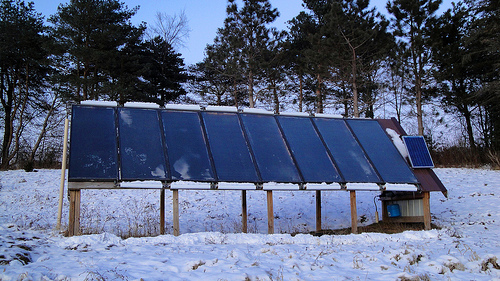What is solar worth to a utility? It’s an issue of national debate, but one unexpected state – Minnesota – is engaging a formal process for determining the methodology for setting the value of solar. As the first multi-utility process, it’s likely to set a precedent nationwide for what the “value of solar” will mean and whether it will aid the continued growth of distributed solar power.
So what’s happening with solar in Minnesota?
Starts with a Standard
It starts with the recently adopted solar energy standard, which requires investor-owned utilities to get 1.5% of their energy from solar by 2020, establishes a standard, long-term contract for buying distributed solar, and allows utilities to file for a “value of solar” tariff (VOST).
The Value of Solar Concept
The “value of solar” concept is designed to solve one of the most pressing problems with expanding solar power. Utilities see customers generating their own energy as a mortal threat to their business model, because the regulatory structure and their business rely on selling kilowatt-hours. The policy in place, net metering, allows customers to get a credit on their bill that’s the same whether they made power from the sun or reduced their energy use by turning off lights. Either way, it means less sales for the utility, but while the utility can’t fight conservation, they can make trouble for solar.
The value of solar concept is a means to catalog and make transparent the many benefits solar energy provides to the grid system (producing energy at times of high demand, being very close to where people use energy). The idea is that utilities would pay solar producers that full value (on a per kilowatt-hour basis) and that customers would reduce their energy bill with the money from that sale, rather than a credit based on how much energy they produce. The benefit to the utility would be transparent, and customers would continue to see how much energy they are using.
Minnesota’s Value of Solar Law
The law sets out the required components of the VOST:
- Energy
- Generation capacity
- Transmission and distribution value
- Transmission capacity
- Environmental value
The law also empowers the responsible state agency (Division of Energy Resources at the Department of Commerce) and Public Utilities Commission to include the value of local manufacturing, systems installed at high value locations on the grid, and other factors.
Setting the value of solar is a two-part process:
- The Department of Commerce’s Division of Energy Resources (DER) develops the methodology/formulas for the utilities to use to calculate the value of solar, due in January 2014.
- The utility files their tariff, as calculated with DER’s methodology, for approval at the Public Utilities Commission
A Stakeholder Road to a Value of Solar Formula
Part 1 of the value of solar process (see link for agendas, presentations, etc) is underway, beginning with a Sept. 17 presentation of the concept, scope, and issues at stake. The meeting was largely focused on a presentation (below) by Lena Hansen and Virginia Lacy from the Rocky Mountain Institute. Since it was basically everyone in Minnesota who is involved in solar policy or the solar business, there were a lot of white men present.
The presentation is an excellent and exhaustive compilation of the potential values of solar. It highlights some of the biggest potential values (like hedging for 30 years or more against natural gas, with volatile prices and that can’t be purchased on a contract longer than 10 years).
Next Steps for MN’s Value of Solar
There were a few questions (the utilities liked throwing a few bombs about the “value of fossil fuels”), but the first meeting mostly set the stage for round 2 on October 1 (agenda and presentation) – a draft of DER’s value of solar methodology and presentations from stakeholders. I’ll be in attendance and live-tweeting (hashtag #MNVOST).
In the meantime, stakeholders submitted their comments on the value of solar methodology (scroll to bottom). You can read my VOST comments here.
Photo credit: CERTs





